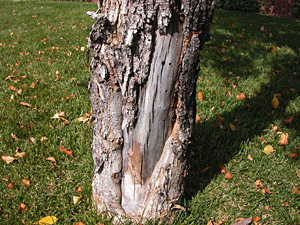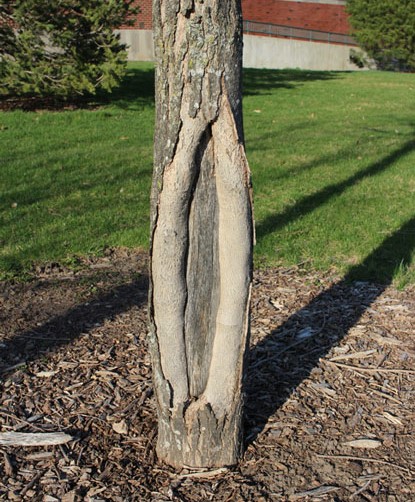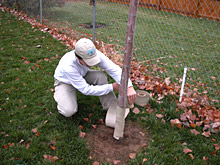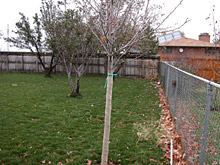WINTER TREE WRAPPING
Bark Protection for Trees
What is Sun Scald on Trees?
Sun scald damage occurs during the winter months. Trees that have direct southern exposure, are highly susceptible to tree bark splitting and sun scald damage. Tree bark damage occurs during warm days when the sun heats the bark on the southern or south-eastern side of the tree. During the night the tree’s bark cools. This repetitive heating and cooling, expands and contracts the tree’s bark. If this expansion and contraction of the tree’s bark continues over and over again it will cause the bark to split, exposing the unprotected inner layer of the tree.
Wrapping a tree with winter tree wrap paper protects the bark by maintaining a more constant temperature. The wrap absorbs the head of the sun, thereby reducing the expansion and contraction of the tree bark.

Preventing Bark Splitting
Which Type of Trees Need to Be Winter Tree Wrapped?
- Young deciduous trees always need to be wrapped. Young trees are especially susceptible to sun scald damage during the first 2-5 years after translating. A general rule is that all newly planted deciduous trees require winter wrapping to protect the thin bark.
- It is recommended to wrap deciduous trees until the tree has a naturally protective thick bark.
- If a deciduous tree is located in direct southern exposure, then winter wrapping is recommended even if it is a tree species that typically does not require annual wrapping. Exception is for trees with white colored bark.
- Certain tree species including ash, honeylocust, and linden trees require annual wrapping. These tree species tend to suffer the most damage from sun scald damage, even when they are mature.
Which Type of Trees Do Not Need to Be Wrapped for the Winter?
- If the tree is located in an area where it receives no sunlight on the bark then it does not need to be wrapped.
- Mature trees with furrowed bark do not require winter tree wrapping.
- Trees that have white bark like aspen and birch trees do not need winter tree wrapping.
- Coniferous trees like fir, spruce, and pines do not need winter tree wrapping.

For questions as to which trees need to be wrapped for the winter, contact one Organo-Lawn and speak with one of our local tree care experts.
Boulder (303) 499-2000 or Fort Collins (970) 225-9425
How to Wrap a Tree for the Winter to Prevent Sun Scald



Winter Tree Wrapping Prices*
Number of Trees – Cost Per Tree 1 – 5 Trees – $10.00 6 – 15 Trees – $9.00 16 – 30 Trees – $8.00 31+ Trees – $7.00
* Minimum trip charge of $45 is required. If we are already at the property doing a different service like aeration or synergy there is no minimum charge.
FAQ – Winter Tree Wrapping
When is the best time to wrap a tree for the winter?
The best time to wrap a tree to protect it from winter sun scald is during the months of October and November.
When should tree wrap be removed?
You should wait to remove the winter tree wrap from your tree until March 1st, but no later than April 15th
What causes sun scald on trees?
Sun Scald is the repeated freezing and thawing of bark following warmer temperatures in the winter season, resulting in permanent visible damage to bark. In the northern hemisphere, it is also called southwest injury because the bark of the tree tends to have the most damage on the southwest side of the trunk.
Winter tree wrap is a very effective tool for protecting the tree’s bark from winter sun scald.